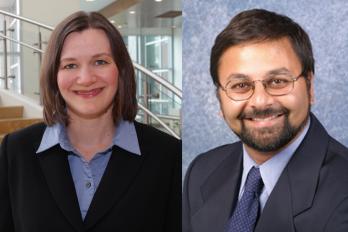Professors Simon and Desai Present at Stanford Law School Conference
August 27, 2012
Thomas Jefferson School of Law Professors Brenda Simon and Deven Desai were presenters at the 12th Annual Intellectual Property Scholars Conference (IPSC) at Stanford Law School from August 9-12.
According to the IPSC, “The IP Scholars Conference brings together intellectual property scholars to present their works-in-progress in order to benefit from the critique of colleagues. The conference is co-sponsored by the Berkeley Center for Law and Technology, UC Berkeley School of Law; the Intellectual Property Law Program, Benjamin N. Cardozo School of Law at Yeshiva University; the Center for Intellectual Property Law and Information Technology, DePaul University College of Law; and the Stanford Program in Law, Science & Technology, Stanford Law School”
Professor Simon spoke about a way to clarify one of the most convoluted and subjective tests of patent law, the analogous arts test. Essentially, she proposed grounding the obviousness analysis in what is actually going on the field to help in the determination.
Professor Desai spoke about the practical effects of the U.S. Supreme Court’s Citizens United v. Federal Election Commission decision finding that in effect corporations are people and how much corporations own and have the power to control their reputations.
Below are abstracts of both Professor Simon and Professor Desai’s presentations:
Clarifying the Analogous Arts Test
Brenda M. Simon
Only art from a field sufficiently analogous to that of the invention can be considered indetermining obviousness. Consequently, obviousness often hinges on whether the court or an examiner deems a reference analogous art. The analogous arts test has been criticized for its subjectivity and viewed as an expedient for approving “complex inventions difficult for judges to understand” and excluding “less mysterious inventions a judge can understand.”1
In KSR, the Supreme Court indicated that a person of ordinary skill should take into account references in other fields, stating that if “a work is available in one field of endeavor, design incentives and other market forces can prompt variations of it, either in the same field or a different one.”2 Courts have expanded the scope of analogous arts to cover ever more divergent fields of invention, yet it is questionable whether evidence from those of ordinary skill in the art would have supported such a broad conception of analogous arts. In light of the expansive range of references available through computerization, crowd-sourcing, and enhanced search capabilities, the question becomes where the limits on analogous art should be.
In determining the scope of analogous arts, courts and examiners should assess whether those of ordinary skill in a given art actually would have considered a reference at the time of invention. Courts should be acutely sensitive to the risks of hindsight bias when relying on their own “common sense” in lieu of expert testimony and other evidence. Focusing the analogous arts determination should help mitigate its subjectivity and bring clarity to a test that can be useful in ascertaining obviousness.
1 Panduit Corp. v. Dennison Mfg. Co., 810 F.2d 1561, 1572 (Fed. Cir. 1987).
2 KSR Int’l Co. v. Teleflex Inc., 550 U.S. 398, 417 (2007) (emphasis added).
Speech, Citizenry, and the Market: A Corporate Public Figure Doctrine
Deven R. Desai
That corporations are people for First Amendment questions is a fait accompli. We can debate the merits or wisdom of that fact, but the fact remains.1 I argue that under current Supreme Court jurisprudence, corporations are not only people, but corporations are public figures. Like other public figures, corporations affect public affairs, take political positions, engage in matters of public concern and public controversy, and have reputations. Corporations no longer exist in a purely commercial world. A host of political issues from fair trade to gay rights to organic farming to children’s development to gender bias to labor and more intersect with and are shaped by corporate policies. Thus Google urges countries to embrace gay rights; Mattel launches a girl power campaign; activists question Nike, McDonald’s, and Shell Oil; and bloggers police the Body Shop’s claims about its manufacturing practices. The social, political, and commercial have converged, and corporate reputations rest on social and political matters as much, if not more, than commercial matters. A foundational commitment of free speech law, perhaps the foundational commitment, is that public figures don’t and can’t own their reputations. Yet, through trade libel, trademark, and commercial speech doctrine corporations have powerful control over their reputation. If corporations are people for free speech purposes, as a constitutional matter, their power to control their reputations can be no greater than the power biological public figures have. Corporations cannot have it both ways. Corporations want and receive many of the benefits natural persons receive. They should also be subject to the same rules as other powerful, public figures.
1 For an excellent discussion of why corporations are different than individuals for speech and other purposes, see C. Edwin Baker, The First Amendment and Commercial Speech, 84 Indiana L. Rev. 981, 987-990 (2009) (arguing that commercial entities as “are created for instrumental purposes” and have “morally different status than living, flesh-and-blood people”); cf Gertz v. Robert Welch, Inc., 418 U.S. 323, 341 (1974) (connecting protection of someone’s good name to dignity) (citations omitted); see also Patricia Nassif Fetzer, The Corporate Defamation Plaintiff as First Amendment Public Figure: Nailing the Jellyfish, 68 Iowa L. Rev. 35, 65-69 (1982) (tracing the Supreme Court’s different approaches to corporate personhood depending on the question presented).
